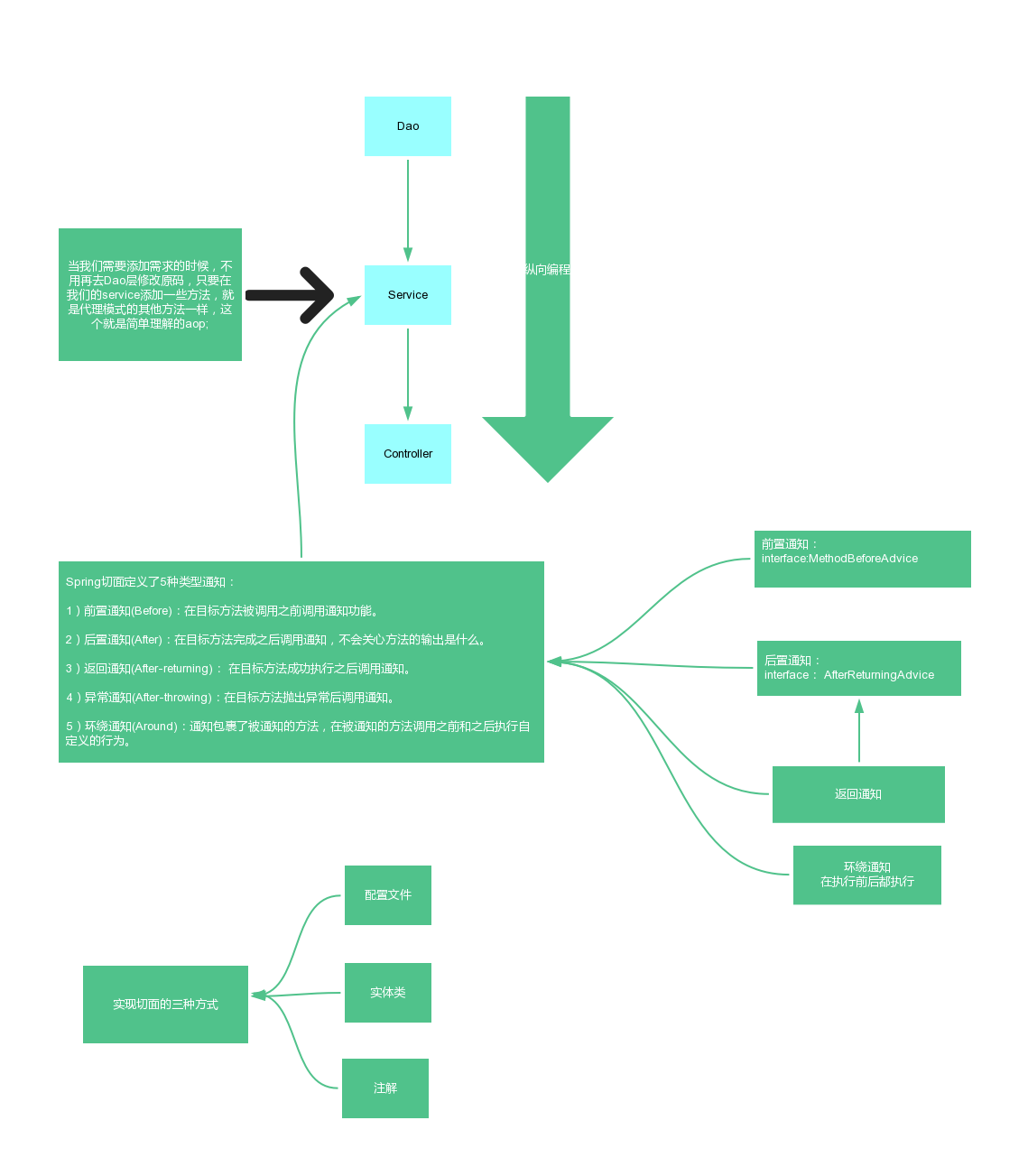Spring AOP
十二、AOP

一、AOP实现方式一
在配置文件中添加支持:
<?xml version="1.0" encoding="UTF-8"?>
<beans xmlns="http://www.springframework.org/schema/beans"
xmlns:xsi="http://www.w3.org/2001/XMLSchema-instance"
xmlns:aop="http://www.springframework.org/schema/aop"
xsi:schemaLocation="
http://www.springframework.org/schema/beans
https://www.springframework.org/schema/beans/spring-beans.xsd
http://www.springframework.org/schema/aop
https://www.springframework.org/schema/aop/spring-aop.xsd">
<!-- more bean definitions go here -->
<bean id="userService" class="com.saxon.UserService.UserServiceImpl"/>
<bean id="before" class="com.saxon.UserService.beforLog"/>
<bean class="com.saxon.UserService.AfterLog" id="afterLog"/>
<aop:config>
<aop:pointcut id="user" expression="execution(* com.saxon.UserService.*.*(..))"/>
<aop:advisor advice-ref="before" pointcut-ref="user"/>
<aop:advisor advice-ref="afterLog" pointcut-ref="user"/>
</aop:config>
</beans>
添加依赖jar包:
<!-- https://mvnrepository.com/artifact/org.aspectj/aspectjweaver -->
<dependency>
<groupId>org.aspectj</groupId>
<artifactId>aspectjweaver</artifactId>
<version>1.9.6</version>
</dependency>
<aop配置>切入点配置:
例:
expression="execution(* com.spring.qq.service.UserServiceImpl.*(..))"
execution()分为五个部分:
1.execution():表达式主体
2.第一个 * 号,表示返回类型,* 号表示所有的类型
3.包路径
4.第二个 * 号, 表示类名,* 号表示所有的类
5.*(..): * 号表示方法名, 括号内为方法的参数, 两个点表示任何参数
需要注意的是我们代理的是一个真实业务的接口而不是一个实现类 Context.getBean ("userService",interface),转换的时候是一个接口
二、实现方法二:自定义类
package com.saxon.Log;
public class Log {
public void before(){
System.out.println ("方法执行前");
}
public void after(){
System.out.println ("方法执行完毕");
}
}
配置文件:
<aop:config>
<aop:aspect ref="Log">
<aop:pointcut id="user" expression="execution(* com.saxon.UserService.*.*(..))"/>
<aop:before method="before" pointcut-ref="user"/>
<aop:after method="after" pointcut-ref="user"/>
</aop:aspect>
</aop:config>
使用切面;
三、Aop实现方式三:使用注解
重要:开启注解支持和在xml里面注册
<aop:aspectj-autoproxy/>
注解注册类:
package com.saxon.Log;
import org.aopalliance.intercept.Joinpoint;
import org.aspectj.lang.ProceedingJoinPoint;
import org.aspectj.lang.annotation.After;
import org.aspectj.lang.annotation.Around;
import org.aspectj.lang.annotation.Aspect;
import org.aspectj.lang.annotation.Before;
@Aspect
public class Log {
@Before ("execution(* com.saxon.UserService.*.*(..))")
public void before () {
System.out.println ("方法执行前");
}
@After ("execution(* com.saxon.UserService.*.*(..))")
public void after () {
System.out.println ("方法执行完毕");
}
@Around ("execution(* com.saxon.UserService.*.*(..))")
public void around (ProceedingJoinPoint jp) {
System.out.println ("环绕前");
try {
Object proceed = jp.proceed ();
System.out.println (jp.getSignature ());
} catch (Throwable throwable) {
throwable.printStackTrace ();
}
System.out.println ("环绕后");
}
}
自学总结
学习地址:狂神说Java
我不是想感动自己,就是想看看自己可以坚持多久,距离你还有多远

 Spring Aop
Spring Aop
